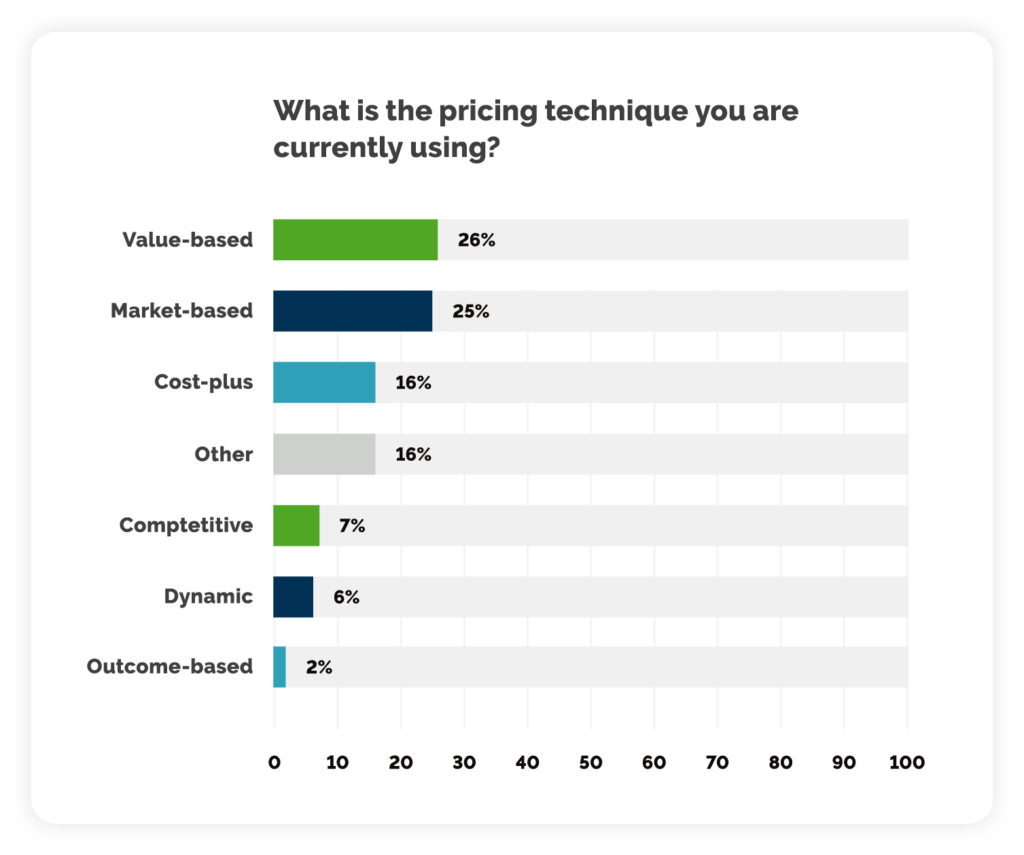
In recent years, value-based pricing has become the most desirable business model for manufacturing, aftermarket, and distribution firms. According to the new Pricing Excellence Report and Outlook 2023 produced jointly by Copperberg and Vendavo, this trend continued in 2022.
How Organizations Price, arrive at the right price for every selling situation, and maintain that process over time is a job owned by changing people and teams including marketing, sales, and finance. While shifts are occurring in who is doing the pricing today, how it’s being computed remains rooted in the value-based pricing model.
The new research shows 26% of survey respondents rely on value-based pricing currently. It’s the top model for many reasons but particularly because it helps organizations unlock new revenue streams and consolidate customer trust by adding value. The value-based model also drives agility and flexibility, making organizations more resilient to changes and market volatility.
Value-based vs Market-based models
For all its benefits, the value-based model can create some challenges for organizations who have fallen behind, especially when it comes to communicating added value. In today’s inflationary environment, those who haven’t had the chance to consolidate their value-based pricing strategy, are having a difficult time increasing prices and justifying them to customers.

Although the high inflation rates are as obvious to customers as they are to suppliers, marketing and sales teams are struggling to efficiently communicate the value to customers.
For this reason, the market-based pricing model is the second most used methodology by survey respondents (25%). Rather than focusing on the customer and their willingness to pay, the market-based model focuses on the value of the product as compared to the competition.
Priority One: Agility
Other pricing models are on organizations’ radars too, including cost-plus and ‘hybrid’ as the ‘other’ category indicates in the above chart. It’s progress to see proactive pricing through the utilization of several different pricing models. As my colleague and senior director, EMEA professional pricing Vendavo, JT Bowlin likes to point out, “There is no one size fits all for pricing; different situations will require different strategies, even within the same company.”
While the value-based pricing model is expected to be more agile than the other models, most organizations still consider their level of pricing excellence to be a work in progress. 72% report their price agility is moderate and just 10% report they have achieved excellent agility.
To improve agility regardless of which approach you use, pricing software is indispensable. It enables companies to streamline the otherwise time-consuming and daunting manual process of setting new prices that match market dynamics and reflect the customer’s willingness to pay, which also changes over time. Yet, 78% of respondents report they aren’t using fully integrated software solutions.
More Work to be Done
The Pricing Excellence Report and Outlook uncovers important insight on progress made within pricing and the overall tone is very positive as more organizations formalize the function, and in some cases centralize it with a dedicated team. Yet, there is much more work to be done. While 49% of survey respondents consider themselves prepared for the future, 51% rate their organizations as unprepared.
This is likely compounded by the global uncertainty ahead, including inflation, volatility, global shifts, supply chain concerns, a possible recession, and more. Macro-events like these can have a massive impact but they are difficult to predict. Because the best offense is often strong defense, resilience and agility are critical characteristics. To get there, companies are undertaking major initiatives, from shifting to value-based pricing and implementing pricing software solutions to envisioning scenarios that incorporate post-inflation prices. By working more closely with sales, using pricing software to build global pricing, employing the right methods for boosting agility, and generally being more proactive, organizations and their pricers are finding success.
For more on the state of pricing today and how it continues to evolve, download the full Pricing Excellence report here.
